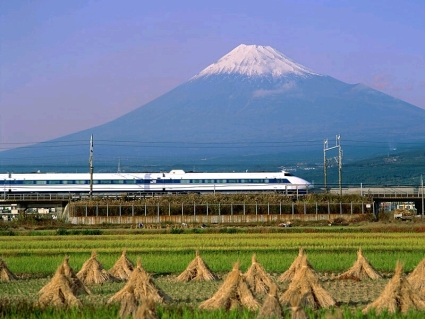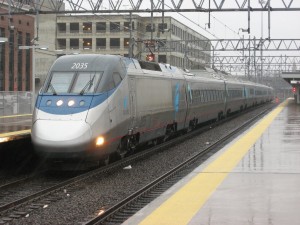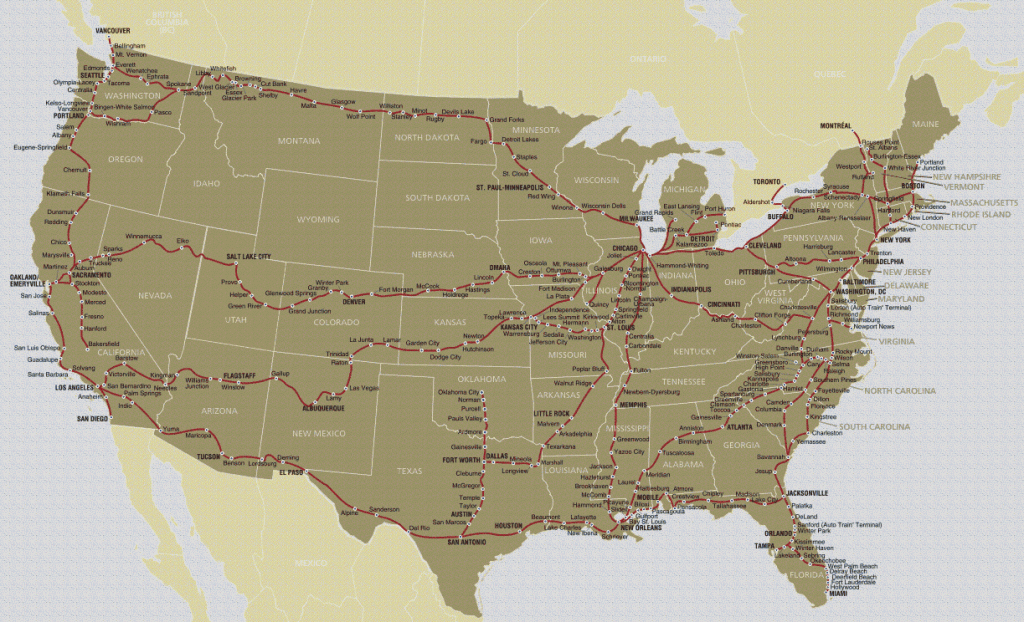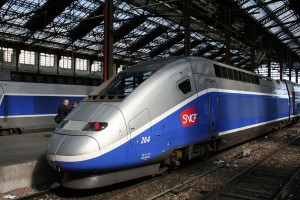Transit 101 is an occasional series that will focus on the history and technology of modern-day public transit systems. The current topic is a primer on the various modes of rail transit.
Part I:Â Streetcars and Interurbans
Part II: Heavy Rail and Light Rail
Part III: Commuter Rail
Part IV: Intercity Rail and High-Speed Rail

Photo: Amtrak
Previous installments of the Transit 101 series have focused on rail travel within a particular metropolitan area, ranging from streetcars within a neighborhood to commuter trains that reach far-flung suburbs. For this final installment on the topic of various modes of rail transit, we will focus on regional and long-distance trains that connect cities with each other. For the purposes of this article, we will focus primarily on intercity rail travel within the United States, which is provided by the National Railroad Passenger Corporation, commonly known as Amtrak. We will also touch upon the development of high-speed rail systems overseas, particularly in France and Japan, and recent efforts to bring high-speed rail to the US.
Amtrak
The previous Transit 101 article on commuter rail includes a brief history of passenger rail in general, as well as a link to a more comprehensive Wikipedia article.
Around the same time commuter rail lines were being divested by railroads and being taken over by public transit agencies, long-distance passenger rail travel was facing a similar situation. In response to this, President Nixon signed the Passenger Rail Service Act in 1970, which created the legal framework for the passenger rail system now known as Amtrak, which was organized the following year.
Opponents of passenger rail, primarily the railroads who wished to see their tracks dedicated to more profitable freight service, saw the creation of Amtrak as a politically expedient way to kill passenger rail altogether, thinking the service would wither and die after only a couple years. Many passenger rail proponents, meanwhile, thought Amtrak would ultimately become self-sustaining. Neither prediction has come true, however. Despite shifts in political fortunes over the years, Amtrak has seen a slow but steady increase in passenger miles traveled, with 27.1 million passengers served in FY 2009. Amtrak currently serves over 500 destinations in 46 US states and three Canadian provinces, in addition to serving as a contract carrier for 15 state-supported rail corridors and four commuter rail agencies throughout the United States.
Amtrak’s intercity rail service can be thought of as falling into one of two broad categories: regional and long-distance. Amtrak’s regional routes are generally less than 500 miles long, and are centered around major cities such as New York and Chicago. Examples of Amtrak regional service include such routes as the Hiawatha line between Chicago and Milwaukee, the Lincoln Service between Chicago and St. Louis, and the various routes that serve the Northeast Corridor between Washington, DC and Boston. Amtrak’s Acela Express on the Northeast Corridor is currently the nation’s only true high-speed rail service, and several other regional corridors are slated for upgrades that will eventually lead to high-speed service. When built, Ohio’s 3C corridor will fall into this category of rail service.
Amtrak regional trains tend to offer more passenger amenities than typical commuter trains, and may include checked baggage, cafe cars, and more comfortable seating with reading lamps and power outlets. However, regional trains typically do not offer the dining facilities and overnight sleeper cars found on the railroad’s long-distance trains. Amtrak regional service in the Midwest and Northeast relies heavily on the distinctive single-level Amfleet coaches built between 1973 and 1983, many of which have now been extensively refurbished.
For long-distance service outside the Northeast Corridor, Amtrak typically operates double-deck Superliner coaches, which offer a number of improvements over the Amfleet coaches. (Superliners do not operate on the Northeast Corridor due to vertical clearance restrictions, particularly in the tunnels leading to and from New York’s Penn Station.) Superliner coaches include coach seating cars, dining cars, cafe/observation cars, and sleeper cars. These cars feature low-level platform boarding onto the lower level of the car, with the upper level serving as the primary riding area. The lower levels are used for entry vestibules, lavatory facilities, seating and sleeping areas for passengers with disabilities, and service areas. This configuration allows passengers to walk through the cars from one end of the train to the other without having to navigate around other passengers who may be waiting to exit the train at the next stop, and the passenger compartment is better separated from drafts that occur when the doors are open, as well as odors from the lavatory facilities.
Distinctive features of Amtrak’s long-distance trains include dining cars that often feature regional cuisine based on where the train is traveling, observation cars that offer cafe service and panoramic views of the passing scenery, and a variety of private sleeper rooms. With such amenities, Superliner trains on Amtrak’s long-distance routes can be thought of as hotels on rails.
Intercity trains outside the Northeast Corridor are typically pulled by diesel locomotives and travel at speeds of up to 79 MPH, although some corridors are in the process of being upgraded for speeds of 110 MPH and faster. Almost all trains on the Northeast Corridor are electric-powered. On some sections of the Northeast Corridor, Acela Express trains reach speeds of 150 MPH, with speeds of 125 MPH common on other parts of the corridor.
As of this writing, Cincinnati’s sole passenger rail service is Amtrak’s Cardinal, which operates between Chicago and New York City three times a week in each direction, calling at Union Terminal.
High-Speed Rail: The Shinkansen and the TGV
 High-speed rail is often thought of as a new technological wonder, but in reality, trains have been operating at speeds of over 100 MPH for over a century. In 1903, an electric-powered train reached a speed of 126 MPH on a military railroad between Marienfeld and Zossen in Germany. The Chicago North Shore and Milwaukee Railroad’s Electroliner interurban cars were tested at 110 MPH and routinely ran at 90 MPH between Chicago and Milwaukee.
High-speed rail is often thought of as a new technological wonder, but in reality, trains have been operating at speeds of over 100 MPH for over a century. In 1903, an electric-powered train reached a speed of 126 MPH on a military railroad between Marienfeld and Zossen in Germany. The Chicago North Shore and Milwaukee Railroad’s Electroliner interurban cars were tested at 110 MPH and routinely ran at 90 MPH between Chicago and Milwaukee.
Despite some experimentation with gas turbine-powered trains in the United States, most technological development related to high-speed rail has taken place overseas, particularly in Japan and France. Each country had seen its rail infrastructure devastated by the Second World War, and were eager to rebuild during the postwar years.
High-speed rail, in the modern sense, got its start in Japan in the 1950’s. The cities of Tokyo and Osaka had a combined population of over 45 million, and existing highway and rail corridors between the two cities had reached capacity. Construction on a dedicated high-speed rail line — using standard-gauge track as opposed to the narrow gauge more commonly found in Japan, and free of grade crossings and interference from other forms of rail traffic — began in 1959 and was opened in time for the Olympics in 1964. The new Shinkansen trains (roughly translating to “bullet” train) reached a speed of 160 MPH during a test run in 1963, and trains in regular passenger service reached top speeds of 130 MPH and maintained an average speed of 101 MPH.
In the years since then, the Japanese high-speed rail network has grown to cover over 1500 miles, and the initial segment between Tokyo and Osaka remains the busiest high-speed rail corridor in the world, with 16-car trains operating every three minutes during peak periods.
This amateur video shows the ride on a 500-Series Shinkansen train from Kyoto to Tokyo:
The success of high-speed rail in Japan, combined with rising oil prices and increased traffic congestion, prompted interest in the development of high-speed rail in Europe. In 1981, France opened its first Train à Grande Vitesse (“high-speed train”), or TGV line between Paris and Lyon, using electric-powered trainsets built by Alstom.
The TGV network now covers over 1000 miles within France and in neighboring countries (including the Channel Tunnel to the United Kingdom), with three new lines currently under construction. The TGV system carried over 98 million passengers in 2008, and generated approximately $1.75 billion in profits for SNCF, the French national railway company, in 2007. Most TGV trains operate at an average speed of up to 173.6 MPH, with top speeds of up to 199 MPH.
On April 3, 2007, a TGV test train driven by Eric Pieczak set a land speed record of 357.2 MPH, the fastest speed ever achieved by a conventional train using steel wheels on steel rails. Maglev trains have achieved faster speeds, but require an entirely new infrastructure to support them, as conventional high-speed trains can operate on mainline railroad tracks shared with other rail traffic, such as when approaching a major urban center.
Of particular interest is the TGV’s remarkable safety record. The advanced signaling system used by the TGV is designed to prevent accidents from occurring in the first place, compared to the American mindset of mandating heavy, fortress-like railcars to protect passengers once an accident has occurred. Despite top speeds of almost 200 MPH, the TGV has never experienced a passenger fatality due to a derailment while running at high-speed. There have been three derailments at high-speed, including an incident in 1993 in which a train derailed while traveling at 186 MPH, the fastest train derailment in history. Due to the stiff, articulated construction of the trainsets that prevent railcars from “jacknifing”, the TGV trains remain upright and parallel with the tracks.
Although not updated in a number of years, the TGVweb site provides an excellent historical and technical overview of the TGV system. In recent years, numerous other countries have begun developing their own high-speed rail networks, particularly Germany, Spain, and China.
The following amateur video shows a variety of passing TGV trains, as seen from the trackside:
High-Speed Rail in the United States

Amtrak's Acela Express at Union Station in New Haven, Connecticut (Photo: Adam Moreira / Wikimedia Commons)
Despite the advances of high-speed rail technology overseas, high oil prices, and increasing congestion on the nation’s highways and in its airports, passenger rail service in general and high-speed rail in particular have been slow to develop in the United States. The reasons are varied, ranging from pressure from oil and highway lobbyists on elected officials, to cumbersome FRA regulations that make it all but illegal to import high-speed rail technology from abroad, to a populace that has now gone several generations without exposure to a large-scale passenger rail network and is now skeptical of its benefits. Fortunately, the tide is turning.
America’s first foray into the world of high-speed rail is in the form of the Acela Express, Amtrak’s premium high-speed service on the Northeast Corridor between Washington, DC and Boston. Planning for the Acela began in 1994, and a joint venture between Bombardier and Alstom was created to manufacture and maintain the trainsets. The first trains in regular passenger service premiered in December 2000, reaching speeds of 150 MPH in some parts of Rhode Island and Massachusetts.
Since its introduction, the Acela Express has captured over half the market share of rail or air travelers between New York and Boston, and is one of the few Amtrak routes to turn a profit. In recent years, the Acela Express service has become a victim of its own success, with trains frequently selling out well in advance, and overcrowding becoming an increasing problem. Additional service was added in 2005, and additional trainsets may soon be purchased to provide further service increases.
Despite its popularity, a variety of technical problems have hindered the Acela Express. Due to FRA crashworthiness regulations, an Acela Express trainset weighs almost twice as much per axle as a comparable TGV trainset. This has led to premature wear on several of the train’s components, particularly the trucks and the braking system. South of New Haven, the Acela Express operates on infrastructure that dates back to the 1890’s in some areas, and is forced to operate at much slower speeds than it would otherwise be capable of, barely reaching 100 MPH in many sections. Crowding on the Northeast Corridor is also an issue, as the Acela Express must share tracks with a wide variety of commuter and regional trains; a delay on one train can have a ripple effect throughout the entire Northeast Corridor. Resolving these issues will require a substantial public investment.
In 2009, President Obama laid out a vision for a nationwide network of high-speed rail lines in the United States, with corridors planned along the East Coast, California, the Southeast, the Pacific Northwest, and in the Midwest. A number of these corridors are now in advanced planning stages, particularly the corridors between St. Louis and Chicago, Tampa and Orlando, and Los Angeles and San Francisco. Some of these corridors will initially be served by diesel-powered trains operating at speeds of up to 110 MPH, while others will be served by electric-powered trains operating at speeds of up to 250 MPH.

Image: WhiteHouse.gov
Although the proposed 3C Corridor between Cincinnati and Cleveland is initially slated to operate 79 MPH conventional trains, long-term plans call for the corridor to be upgraded to high-speed service. Along with high-speed rail service to Chicago via Indianapolis, and potential high-speed service to New York via Columbus and Pittsburgh, Cincinnati is poised to become an important hub for high-speed rail in the Midwest. With rapid transit access between Union Terminal and the Cincinnati – Northern Kentucky International Airport, high-speed rail trains have the potential to serve as feeders to long-distance air travel, and could position our airport as a viable alternative to larger airports such as O’Hare and Hartsfield.





